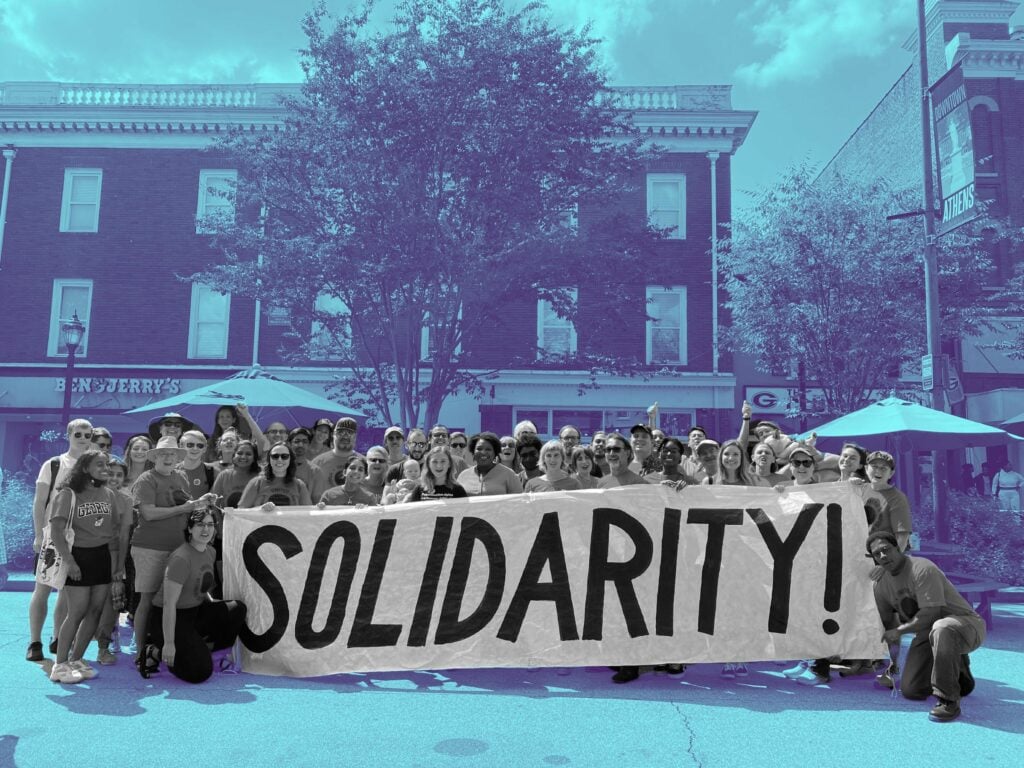This is the second in a series of reflections on the opportunities and challenges facing the labor movement this year. How can the movement use the momentum of 2023 to keep building power? How should it set its strategic compass? What kinds of organizing can help it navigate our shifting economy and rough political terrain?
This year already has our movements on edge. In 2020 our directive was so clear. Living through four years of Trump created a palpable urgency around the election. Living through four years of Biden has been qualitatively different—less chaotic, sometimes lighter, with a shred more possibility. Those of us in labor are especially heartened by working with the most pro-worker National Labor Relations Board we’ve seen in some time.
With the same MAGA threat at hand in 2024, we appear rudderless after that hard-fought 2020 victory hasn’t been rewarded with more decisive power for the progressive Left. Heartbreaking images pouring out of Gaza remind us daily of the power imbalances our movements face in American democracy. We have mobilized relentlessly to stop the genocide—but although we’ve moved public opinion, we haven’t moved our leaders.
For many this moment has engendered a complete lack of faith in engaging with an inside-outside strategy. From where I sit, in the labor movement in Tennessee, I offer this: we’ve always been looking at a long game.
In 2024 we could see a qualitative shift in progressive movements’ approach to elections. Previous election years have drawn huge, persistent dividing lines in left circles as we rally around candidates we admire and fight it out in the primaries. This time, let’s put our differences aside for the general election, collectively focus on defeating our common enemy, the MAGA Right, and advance our forces within a pro-democracy front to weaken the fascists and create better conditions for ourselves.
We have to remember that achieving favorable electoral outcomes is not the end game in itself. In the process of organizing for the best outcomes we can muster in a world of limited options, we can position ourselves more powerfully to organize independently for the world we actually want.
Focus on state battlegrounds too
The White House is not the only battleground that matters. In states like Tennessee we have a hundred little Donald Trumps in our legislatures who pass bill after bill to restrict reproductive rights, attack trans people, undermine public schools, erode labor rights, deny voting rights, and more. At the same time, as more resources are invested in organizing in southern states, many more people have been getting a taste of a different way of being that is translating into breakthroughs we haven’t expected. This has meaningful implications for the prospects of investing capacity in states that might be otherwise written off as “impossible” or “hopeless.”
For example: in March 2023, a tragic mass shooting at a school in Nashville, TN, motivated thousands of people to flood the Tennessee Capitol for days to demand gun reform. Three legislators, Justin Jones, Justin Pearson, and Gloria Johnson—known as the Tennessee Three—led protests from the streets to the Capitol steps day after day, and together, took action on the House floor to push for meaningful reform.
These popular actions drew a shocking censure from their legislative colleagues. The entire country’s eyes were on Tennessee as the legislature voted to expel Jones and Pearson, two young Black legislators, from their democratically elected posts, while sparing Johnson, who is white. Jones and Pearson were able to win back their seats and continued to harness the movement built around gun control and advance the conversation around the stakes of the struggle for democracy in Tennessee. In that moment, they drew a clear line from the fights we wage around issues like gun control to the fight for democracy itself.
The Tennessee Three’s breakthrough represented decades of investment in movement capacity by everyday people organizing around all kinds of issues: workers’ rights, gender justice, environmental justice, and more. They are the faces of a growing movement for democracy and justice, cultivated by disciplined organizers, reaching hundreds of thousands of Tennesseans in their lives and workplaces, seeking to transform our state.
We know attacks will keep coming in 2024: they will as long as the Republicans remain in power. As urgent as the attacks on our people are, our movement will need to fight back while also keeping our eyes on the horizon. What if we set out on a multigenerational path to make every “red” state winnable? The path to overcoming the perpetual stalemate that is plaguing our country is to take a hard look at enemy strongholds, and break through.
As the clock ticks on this year, with the very real possibility of a repressive, revanchist administration looming, I hope we’ll see more candidates advancing at the state level and in Congress that can undermine the worst impulses of the fascist threat. This year gives us an opportunity to consolidate our movements and build a united front against our common enemy, the new confederate MAGA Right. In doing so, we can also advance what we are largely for: an expansion of democracy, an independent vision of a better world with racial justice, economic justice, gender justice, democratic foreign policy, urgency afforded to the climate emergency and ecological justice.
Unions offer a taste of democracy
This project can be fueled in part by a reinvigorated labor movement that can grow stronger through and after the election: the fortunes of labor do not depend only on electoral outcomes. Unions appeal to so many people in part because they provide independent vehicles to organize proactively outside of the strictures and the all-or-nothing stakes of elections. They give people a chance to experiment with and experience meaningful democratic process, to not only campaign and agitate, but also to govern an organization, and to realize a vision for a different world.
The bravery workers have shown in 2024 has already been rewarded with victories – a breakthrough at Starbucks Workers United, and there’s good reason for hope on the horizon – video game workers in CWA working to set industrial standards with powerful contracts, and journalists waging righteous strike fights.
In the public sector where I work, we build unions in states without collective bargaining rights or legal recognition. Members join as dues-payers, one by one, without the expectation of a contract, but with the promise of being a part of a fight for change: we work toward long-term transformation with concrete victories along the way. I hope to see workers in these unions not only beat back attacks but launch powerful, positive campaigns to reshape the landscape of struggle – campaigns to win living wages and protect the public good, campaigns that will help them build community with one another in a society where widespread loneliness is just one symptom of the profound disorganization of working people.
I hope we see major union conventions result in more organizational shake-ups that challenge the highest levels of labor bureaucracies to do more, be more, and win more; such shake-ups animated 2023 and contributed to a “hot labor summer” of militancy that paid off for workers. Did anyone expect to see an auto parts facility in Tuscaloosa go on strike this year? I didn’t. And what a profound thing for those workers to see their union not just as a deduction on a check, or a contract to enforce, but a vehicle for action.
One thing I maintain for 2024 is confidence we will continue to grow our labor movement. This upsurge in recent years has led to more trained organizers, more passionate commitments, and more budding strategists who ache for the kind of movement that was strong enough to win the National Labor Relations Act in the first place. As a red-state resident, I see the labor movement as the most productive place to spend my energy for this reason. More begets more begets more – and we need more activists, we need more organizers, we need more people stepping up to take on the problems of our world with great seriousness, hope, and a mischievous, anti-authoritarian spirit.
I remember visiting members on campus on November 9, 2016 and the fear and uncertainty we all shared in those last days before Trump took office. It was grim. The loss felt so obvious and so painful. But it wasn’t the end of our story. In the years after Trump’s election, my union, United Campus Workers-CWA, grew from one local in Tennessee to now over 7000 members in nine states where the path to legal recognition is long and winding. We’ve won base pay raises, we’ve fended off privatization, we’ve improved the lives of many people and we’re just getting started.
I sincerely hope we don’t feel the grim disappointment of another MAGA victory, while also I am doubtful about feeling the same energy I felt in 2020 if we are able to defeat Trump this time. But in spite of whatever is happening, our union is ours, something we build together across generations, across electoral cycles, across crises and conundrums. And it remains a good thing, a productive place to be, in the toughest of moments. I hope in 2024 more people have the opportunity to find that sense of purpose through our labor movement.
Featured image: UCW GA members rally for Stacey Abrams when she was running for governor in 2022. Photo by Melody Oliphant.
Did you enjoy this article?
We're in the middle of our annual fund drive, and this year we're building our own internal infrastructure for subscriptions, meaning more of every dollar pledged goes to fulfilling our mission. Subscribe today to support our work and be a part of Convergence's next evolution.

